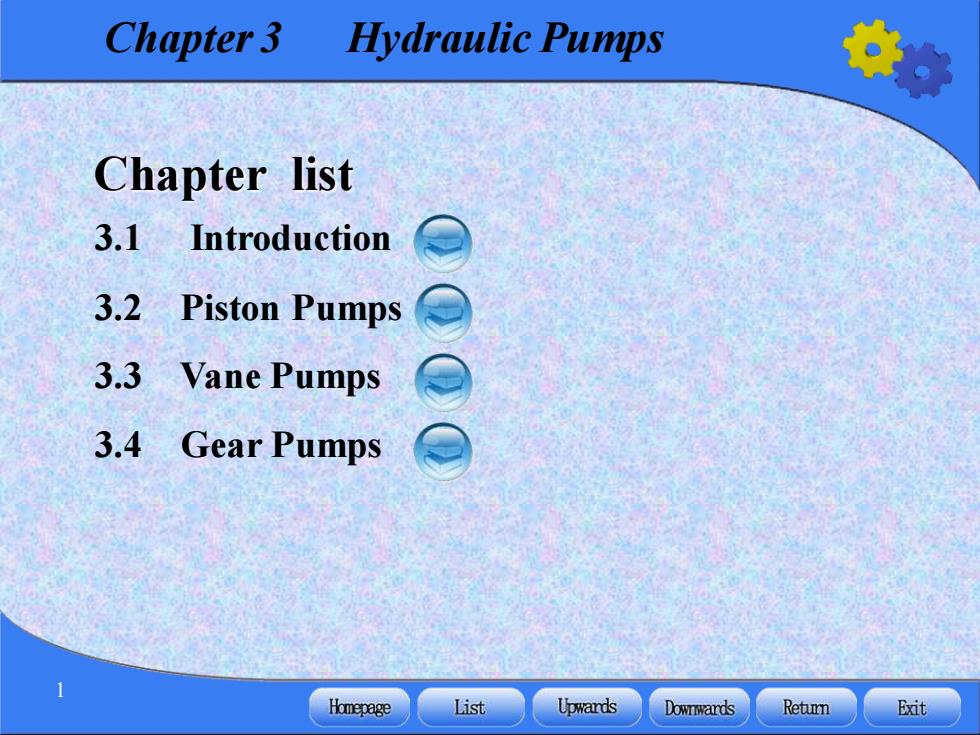
Chapter 3 Hydraulic Pumps 妆 Chapter list 3.1 Introduction 3.2 Piston Pumps 3.3 Vane Pumps 3.4 Gear Pumps Homepage List Upwards Dowrwards Retumn Exit
Chapter 3 Hydraulic Pumps 1 Chapter list 3.1 Introduction 3.2 Piston Pumps 3.3 Vane Pumps 3.4 Gear Pumps
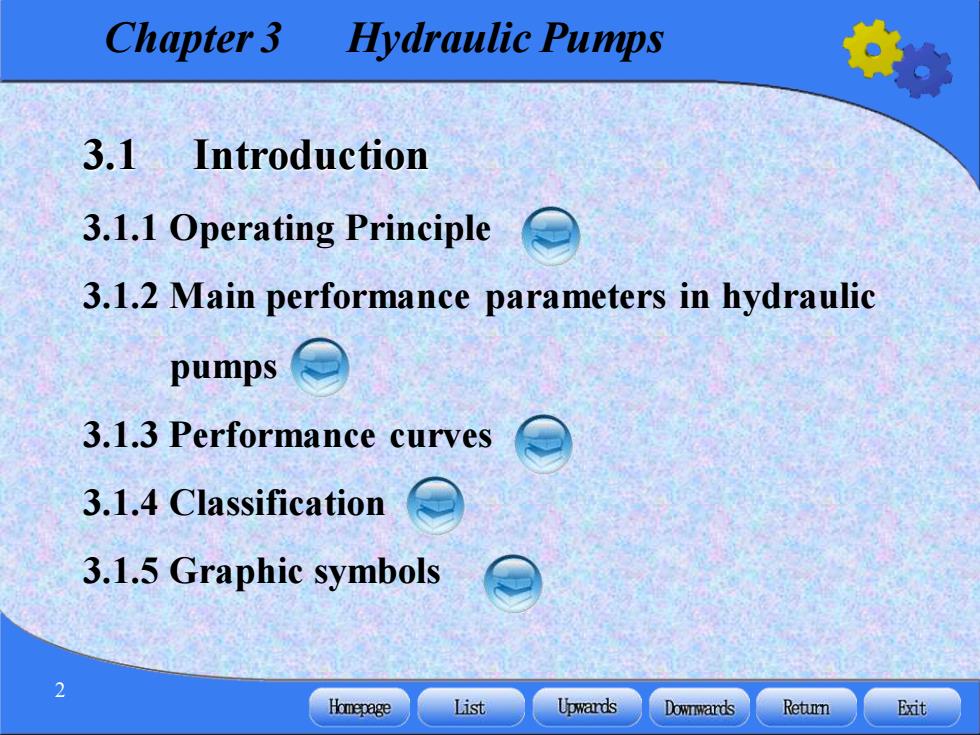
Chapter 3 Hydraulic Pumps 3.1 Introduction 3.1.1 Operating Principle 3.1.2 Main performance parameters in hydraulic pumps 3.1.3 Performance curves 3.1.4 Classification 3.1.5 Graphic symbols 2 Homepage List Upwards Downwards Retumn Exit
Chapter 3 Hydraulic Pumps 2 3.1 Introduction 3.1.1 Operating Principle 3.1.2 Main performance parameters in hydraulic pumps 3.1.3 Performance curves 3.1.4 Classification 3.1.5 Graphic symbols
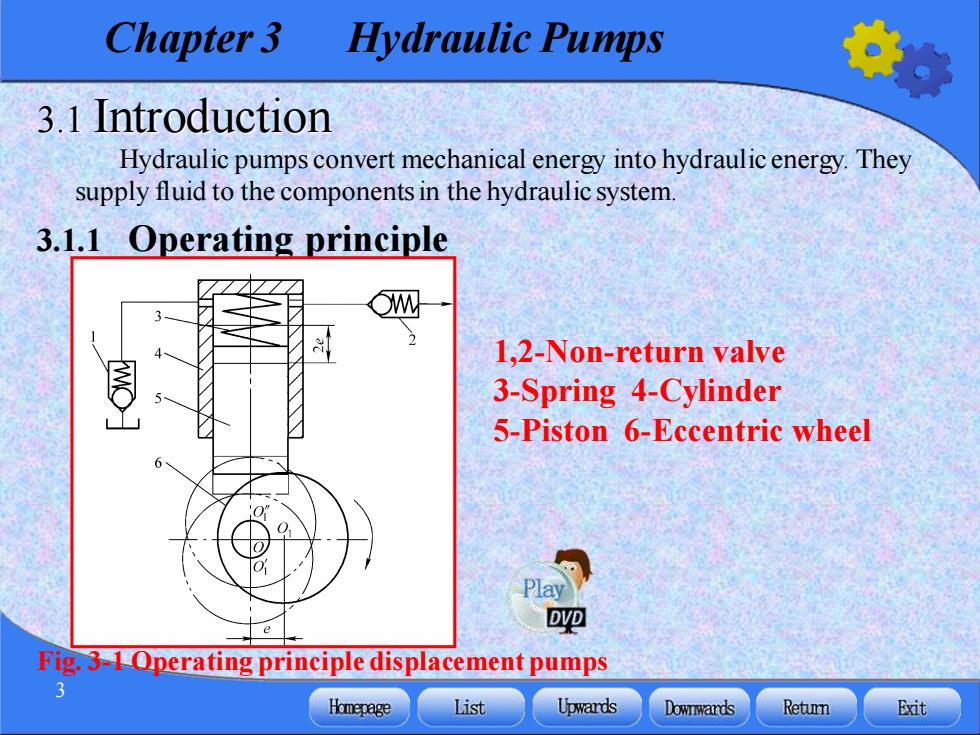
Chapter 3 Hydraulic Pumps 3.1 Introduction Hydraulic pumps convert mechanical energy into hydraulic energy.They supply fluid to the components in the hydraulic system. 3.1.1 Operating principle 1,2-Non-return valve 3-Spring 4-Cylinder 5-Piston 6-Eccentric wheel Play y吧 Fig.3-1 Operating principle displacement pumps Homepage List Upwards Downwards Retumn Exit
Chapter 3 Hydraulic Pumps 3 3.1 Introduction 3.1.1 Operating principle Hydraulic pumps convert mechanical energy into hydraulic energy. They supply fluid to the components in the hydraulic system. 1,2-Non-return valve 3-Spring 4-Cylinder 5-Piston 6-Eccentric wheel Fig. 3-1 Operating principle displacement pumps
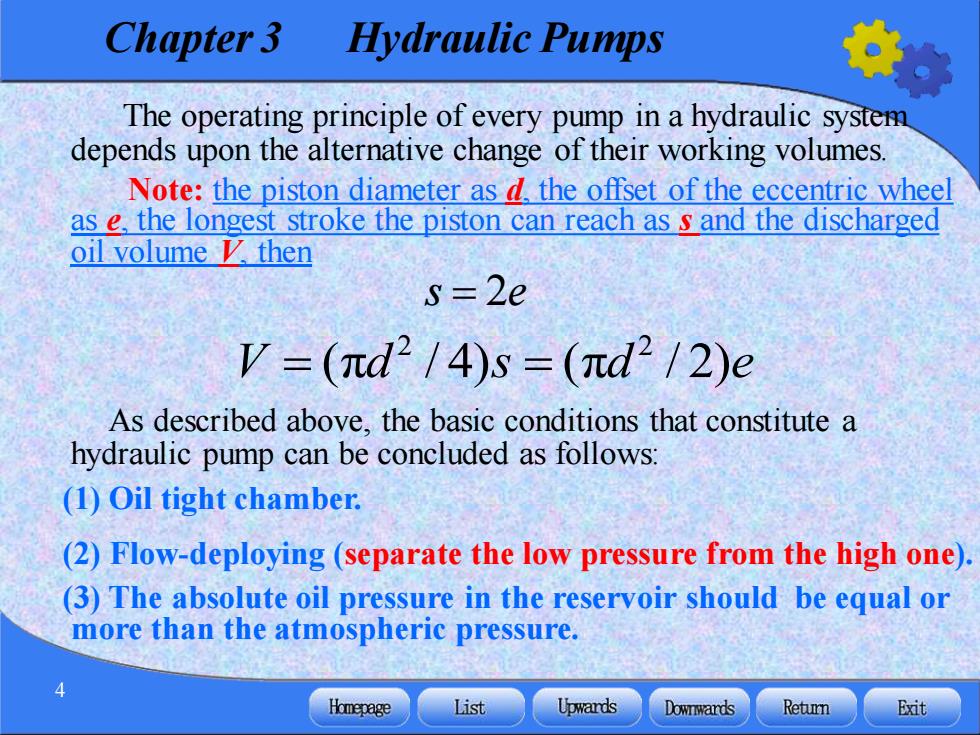
Chapter 3 Hydraulic Pumps The operating principle of every pump in a hydraulic system depends upon the alternative change of their working volumes. Note:the piston diameter as d the offset of the eccentric wheel as e,the longest stroke the piston can reach as s and the discharged oil volume V then s 2e V=(πd2/4)s=(πd2/2)e As described above,the basic conditions that constitute a hydraulic pump can be concluded as follows: (1)Oil tight chamber. (2)Flow-deploying(separate the low pressure from the high one). (3)The absolute oil pressure in the reservoir should be equal or more than the atmospheric pressure. Homepage List Upwards Downwards Retumn Exit
Chapter 3 Hydraulic Pumps 4 The operating principle of every pump in a hydraulic system depends upon the alternative change of their working volumes. Note: the piston diameter as d, the offset of the eccentric wheel as e, the longest stroke the piston can reach as s and the discharged oil volume V, then As described above, the basic conditions that constitute a hydraulic pump can be concluded as follows: (1) Oil tight chamber. (2) Flow-deploying (separate the low pressure from the high one). (3) The absolute oil pressure in the reservoir should be equal or more than the atmospheric pressure. s e = 2 2 2 V d s d e = = (π / 4) (π / 2)
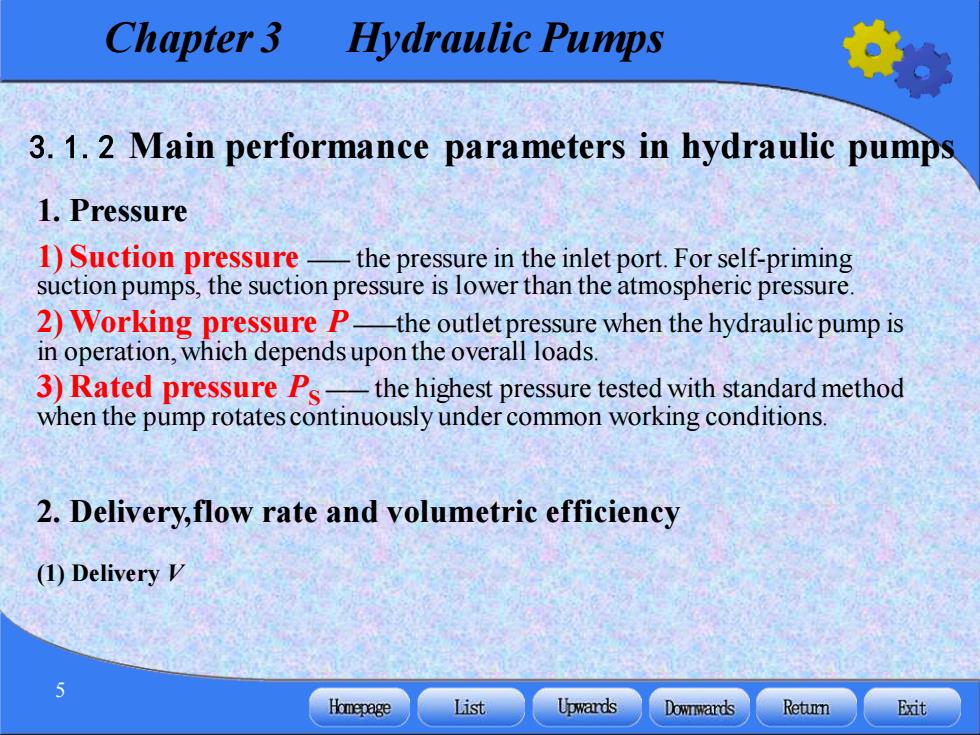
Chapter 3 Hydraulic Pumps 3.1.2 Main performance parameters in hydraulic pumps 1.Pressure 1)Suction pressure-the pressure in the inlet port.For self-priming suction pumps,the suction pressure is lower than the atmospheric pressure 2)Working pressure P-the outlet pressure when the hydraulic pump is in operation,which depends upon the overall loads. 3)Rated pressure Ps-the highest pressure tested with standard method when the pump rotates continuously under common working conditions. 2.Delivery,flow rate and volumetric efficiency (1)Delivery V Homepage List Upwards Downwards Retumn Exit
Chapter 3 Hydraulic Pumps 5 3.1.2 Main performance parameters in hydraulic pumps 1. Pressure 1) Suction pressure —— the pressure in the inlet port. For self-priming suction pumps, the suction pressure is lower than the atmospheric pressure. 2)Working pressure P ——the outlet pressure when the hydraulic pump is in operation, which depends upon the overall loads. 3) Rated pressure PS —— the highest pressure tested with standard method when the pump rotates continuously under common working conditions. 2. Delivery,flow rate and volumetric efficiency (1) Delivery V
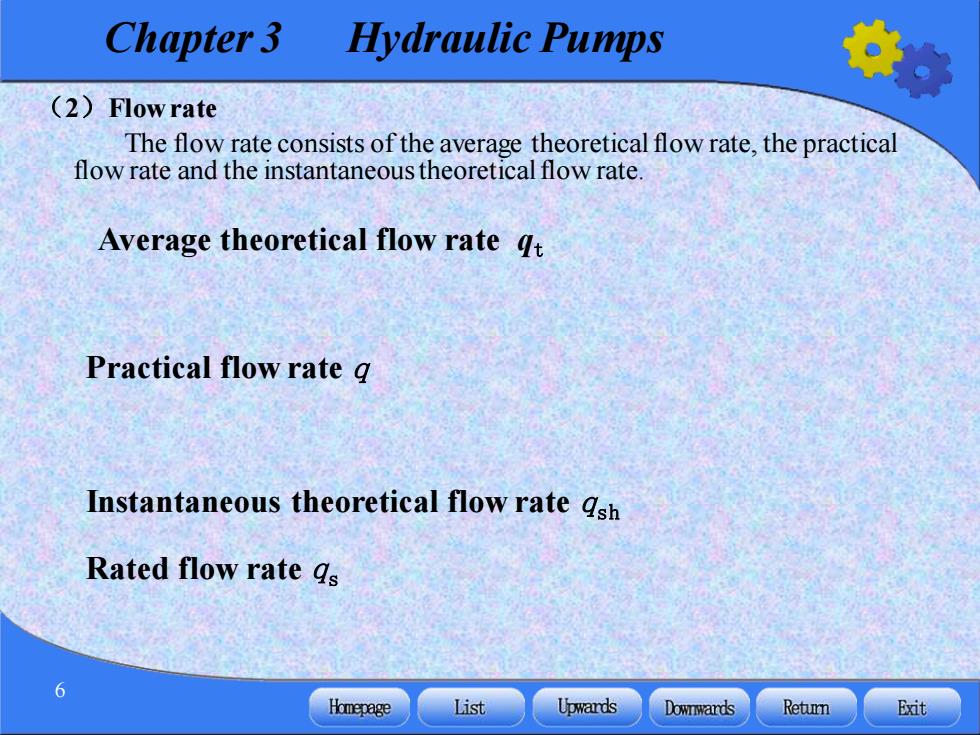
Chapter 3 Hydraulic Pumps (2)Flowrate The flow rate consists of the average theoretical flow rate,the practical flow rate and the instantaneous theoretical flow rate. Average theoretical flow rate qt Practical flow rate g Instantaneous theoretical flow rate ash Rated flow rate 9s Homepage List Upwards Downwards Retumn Exit
Chapter 3 Hydraulic Pumps 6 (2)Flow rate The flow rate consists of the average theoretical flow rate, the practical flow rate and the instantaneous theoretical flow rate. Average theoretical flow rate qt Practical flow rate q Instantaneous theoretical flow rate qsh Rated flow rate qs
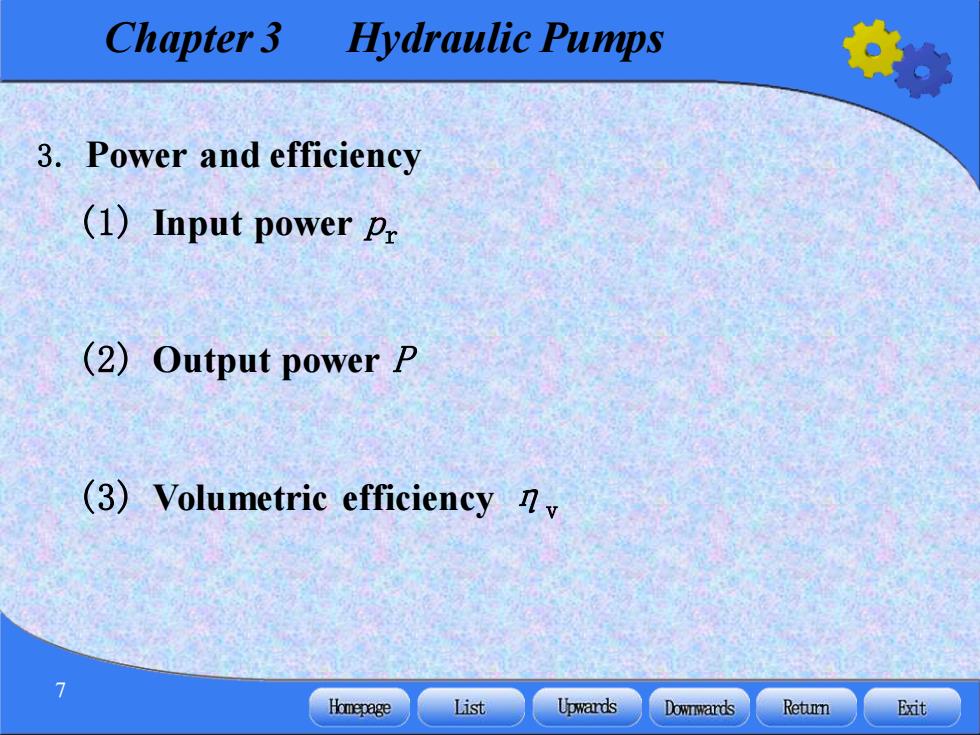
Chapter 3 Hydraulic Pumps 3. Power and efficiency (1)Input power pr (2)Output power P (3)Volumetric efficiencyv Homepage List Upwards Downwards Retumn Exit
Chapter 3 Hydraulic Pumps 7 3. Power and efficiency (1) Input power pr (2) Output power P (3) Volumetric efficiency ηv
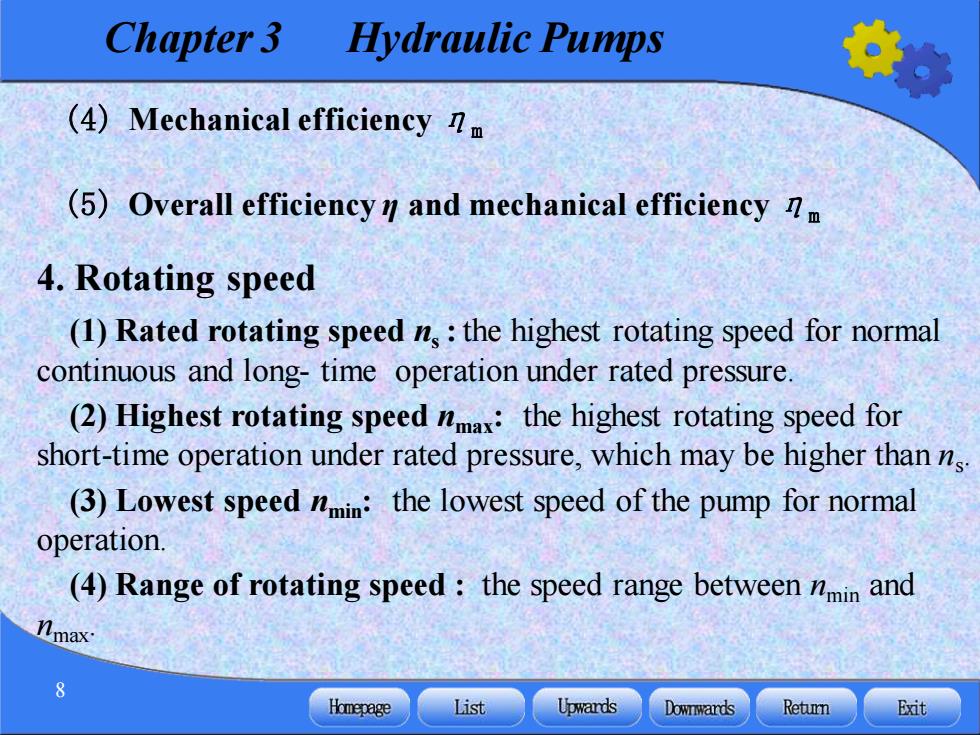
Chapter 3 Hydraulic Pumps (4)Mechanical efficiency 1m (5)Overall efficiency y and mechanical efficiency nm 4.Rotating speed (1)Rated rotating speed n:the highest rotating speed for normal continuous and long-time operation under rated pressure. (2)Highest rotating speed:the highest rotating speed for short-time operation under rated pressure,which may be higher than ns (3)Lowest speed nmin:the lowest speed of the pump for normal operation (4)Range of rotating speed:the speed range between nmin and nmax 8 Homepage List Upwards Downwards Retumn Exit
Chapter 3 Hydraulic Pumps 8 (4) Mechanical efficiencyηm (5) Overall efficiency η and mechanical efficiencyηm 4. Rotating speed (1) Rated rotating speed ns : the highest rotating speed for normal continuous and long- time operation under rated pressure. (2) Highest rotating speed nmax: the highest rotating speed for short-time operation under rated pressure, which may be higher than ns . (3) Lowest speed nmin: the lowest speed of the pump for normal operation. (4) Range of rotating speed : the speed range between nmin and nmax
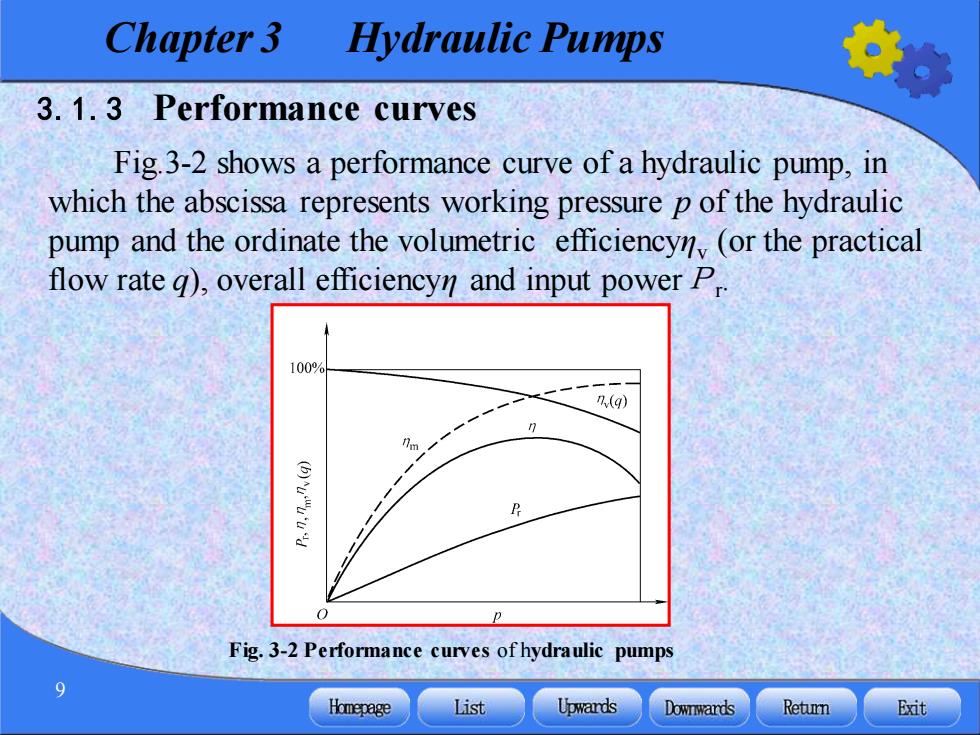
Chapter 3 Hydraulic Pumps 3.1.3 Performance curves Fig.3-2 shows a performance curve of a hydraulic pump,in which the abscissa represents working pressure p of the hydraulic pump and the ordinate the volumetric efficiencyn(or the practical flow rate g),overall efficiencyn and input power P 100% n(q) Fig.3-2 Performance curves of hydraulic pumps Homepage List Upwards Downwards Retumn Exit
Chapter 3 Hydraulic Pumps 9 3.1.3 Performance curves Fig.3-2 shows a performance curve of a hydraulic pump, in which the abscissa represents working pressure p of the hydraulic pump and the ordinate the volumetric efficiencyηv (or the practical flow rate q), overall efficiencyη and input powerPr . Fig. 3-2 Performance curves of hydraulic pumps
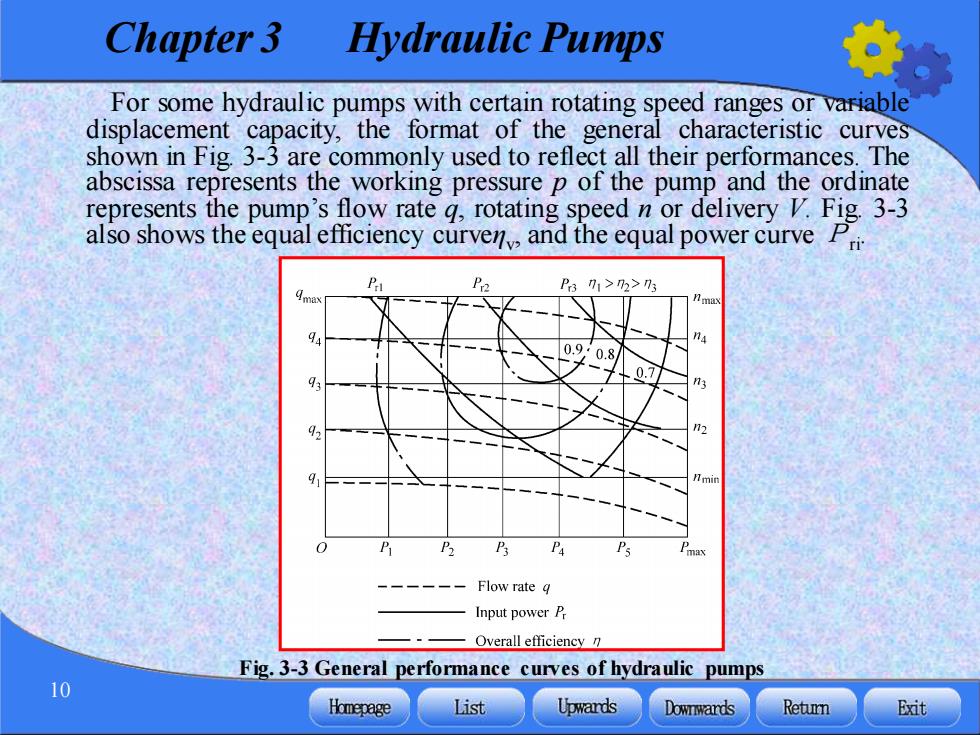
Chapter 3 Hydraulic Pumps For some hydraulic pumps with certain rotating speed ranges or variable displacement capacity,the format of the general characteristic curves shown in Fig 3-3 are commonly used to reflect all their performances.The abscissa represents the working pressure p of the pump and the ordinate represents the pump's flow rate g,rotating speed n or delivery V.Fig 3-3 also shows the equal efficiency curven and the equal power curve Pri P31>2>n3 92 Flow rate q Input power P Overall efficiency n Fig.3-3 General performance curves of hydraulic pumps 10 Homepage List Upwards Downwards Retumn Exit
Chapter 3 Hydraulic Pumps 10 For some hydraulic pumps with certain rotating speed ranges or variable displacement capacity, the format of the general characteristic curves shown in Fig. 3-3 are commonly used to reflect all their performances. The abscissa represents the working pressure p of the pump and the ordinate represents the pump’s flow rate q, rotating speed n or delivery V. Fig. 3-3 also shows the equal efficiency curveηv , and the equal power curve Pri. Fig. 3-3 General performance curves of hydraulic pumps